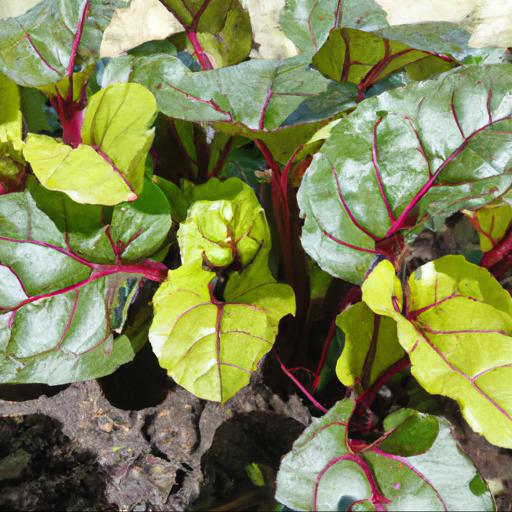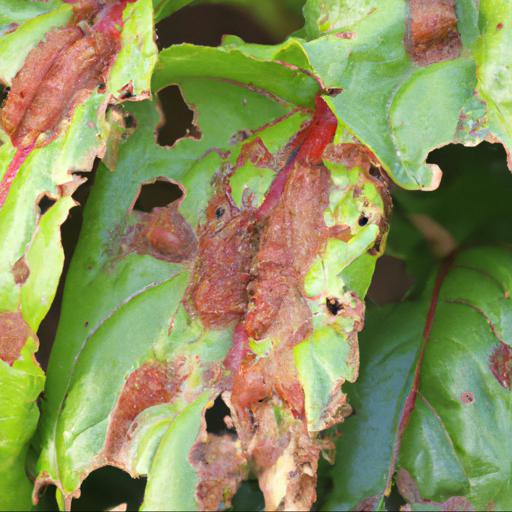Beta vulgaris Red Ace is a variety of the plant species Beta vulgaris, commonly known as beetroot or garden beet. It is a popular vegetable in many parts of the world, and is known for its vibrant red color and sweet, earthy flavor. It is a great source of vitamins and minerals, and is a popular addition to salads, soups, and other dishes.
Red Ace is a reliable variety that produces a large, round root and resists bolting. It is easy to grow and produces a high yield.
With its sweet flavor and beautiful color, Beta vulgaris Red Ace is an excellent choice for gardeners looking to add a nutritious and delicious vegetable to their garden.
Benefits of growing beta vulgaris red ace
Beta vulgaris red ace is a variety of beets with a deep purple, almost burgundy color. This variety of beets has a sweet, earthy flavor and its leaves are even sweeter than the root.
Growing red ace beets is becoming a popular choice in gardens and allotments across the UK. Not only do they look stunning, but they have a range of benefits as well. The first benefit of growing red ace beets is their incredibly quick growth rate.
After planting red ace beet seeds, the first harvest can come in as little as 40 to 45 days. This means it’s possible to get two harvests in one season. Additionally, for those who only want the leaves of the vegetable, those can be harvested prior to the roots reaching maturity.
Another benefit of growing red ace beets is their extremely versatile culinary possibilities. When it comes to beets, most people think of them as a side dish, boiled or mashed.
However, red ace beets make a great accompaniment to salads or sandwiches as they have a delicious earthy taste. They can also be cut up into wedges or coins to be added to soups or stews. Roasting beets in the oven is also a great way to enjoy them as it brings out the sweetness and enhances their flavor.
Finally, red ace beets are a great way to improve the soil in your garden. Beets act as a dynamic accumulator, and their greens are full of important basic trace elements that are released into the soil.
These nutrients help the other plants in your garden grow and provide more nutrition for your family. As an added benefit, red ace beets can also help reduce the impact of some weeds. Growing red ace beets is a great choice for any UK-based gardener looking for a nutritious, delicious and easy-to-grow vegetable. It has all the benefits of a traditional beet, with a deep and sweet flavor, rapid growth rate and versatile culinary possibilities. Additionally, it helps improve the soil and is a good companion for many other plants. Red ace beets are a must for any garden looking to produce beauty and nutrition.
Tips for growing beta vulgaris red ace

Beta vulgaris red ace is a common and popular beetroot variety in the UK, frequently used in home gardens and allotments. It is renowned for its luscious deep red roots with a sweet and slightly earthy taste. Growing Beta vulgaris red ace is relatively easy and straightforward, making it the perfect option for both novice and experienced gardeners.
When growing Beta vulgaris red ace, the most important thing is to keep the soil as moist as possible. This can be done by applying a thick layer of mulch to the surface of the soil and by using a drip irrigation system.
Additionally, it is important to ensure adequate sunlight exposure, as beetroots will not grow without at least 6 hours of direct sun each day. Additionally, it is important to fertilize the soil with a balanced fertilizer in the spring and the summer.
When planting Beta vulgaris red ace, it’s best to space the seeds about 7 cm apart. If there is not enough space for all the seedlings, thinning should be done after emergence. Once the beetroots reach a good size, they can be harvested.
Be sure to use gloves when harvesting them to protect your hands from any sap released. Overall, growing Beta vulgaris red ace is relatively easy and can provide a tasty addition to your meals all year round.
With the right care, your beetroots can provide you with a nutritious and delicious crop that can last up to 6 months. So why not give growing Beta vulgaris red ace a try?
Common pests and diseases of beta vulgaris red ace

Beta vulgaris red ace is a popular variety of beetroot, grown and enjoyed around the world. It has a bright, red, slightly sweet flavor and is packed with nutrients, making it a favorite in many kitchens.
While this vegetables offers many benefits, there are also some pests and diseases that can affect its growth and quality, so it is important for gardeners to be aware of what to look out for. One of the most common pests found on beta vulgaris red ace is the flea beetle. These small, black beetles can chew through the leaves of the plant, leaving behind small “shot holes” in the foliage.
If left unchecked, flea beetle infestations can cause severe damage to the plant. To prevent them from settling in, gardeners should use row covers or screens to create a physical barrier between the beetles and the plants and also incorporate crop rotation into their rotation plans.
In addition to flea beetles, beta vulgaris red ace can also be susceptible to root knot nematodes. These microscopic worms feed on the roots of the plant, weakening and stunting the growth. Symptoms of an infestation include yellowing foliage and wilting of leaves.
To prevent this, gardeners should ensure they are using clean soil to start their plants and avoid over-watering. Finally, beta vulgaris red ace can be susceptible to Alternaria leaf spot, which is caused by a fungus. This manifests itself in a leaf blight, with yellow spots appearing on the foliage.
To manage this, gardeners should take care not to over-water their plants, as this can encourage the growth of the fungus. Additionally, it’s important to remove any affected foliage as soon as possible to prevent its spread.
In conclusion, beta vulgaris red ace is a great vegetable to grow but there are some common pests and diseases that can affect its growth and quality. Gardeners should be aware of potential threats such as flea beetles, root knot nematodes and alternaria leaf spot and take steps to prevent or manage any infestations.
Recipes using beta vulgaris red ace
Beta vulgaris Red Ace is a variety of red beet most commonly grown in the UK and across Europe. Its sweet, earthy flavour is a popular ingredient in salads, soups, and side dishes. Red Ace is an attractive vegetable, with its super-vibrant red hues and round shape.
Red Ace turnips are also sought after for their decorative qualities, adding a pop of colour to the garden. One standout recipe for the Red Ace is the classic beetroot and goat’s cheese salad.
It’s incredibly simple and delicious, combining caramelized beetroot slices with salt-kissed goats’ cheese. Fresh flat-leaf parsley and a light, zesty lemon dressing give it a definitive Mediterranean ambiance. The beetroot is boiled until tender, then cooled and peeled before being cut into quarters.
Another fantastic way to use Red Ace is in a seasonal roasted vegetable soup. The beetroot is diced, mixed with other root vegetables like carrots, potatoes, and onions and then roasted with herbs and spices until caramelized.
Purée the finished soup in a food processor and add a dollop of sour cream to creamify the texture. Vegetable lasagna is another fantastic way to use Red Ace. Layer slices of the beetroot with lasagne sheets and creamy béchamel sauce, a sprinkle of Parmesan, and some thyme.
Bake in the oven until the topping is golden and serve with a Caesar salad. Red Ace is also a great addition to desserts.
Beat the Red Ace in a food processor and combine it with orange juice, dark chocolate, ground almonds, and honey. Roll into 1-inch balls and chill. This makes a fantastic no-bake energy bite which can be enjoyed as a snack or as a healthier dessert. Red Ace is also great with tomatoes in a tartlet, topped with a crumble topping and some more goats’ cheese. With its versatile flavour, Red Ace is a great way to brighten up any recipe for a diverse range of dishes.
Bottom Line
Beta vulgaris red ace is a variety of beetroot, known for its sweet taste and deep red color. It is a popular choice for salads, soups and other dishes. The beetroot is high in vitamins and minerals, and is a good source of dietary fiber.
It is low in calories and a great source of antioxidants. Beta vulgaris red ace can help reduce inflammation, and may even help lower blood pressure.
It is also a great source of iron, which is important for healthy blood cells. Try adding some Beta vulgaris red ace to your next meal for a tasty and nutritious boost.
FAQ
What are the nutritional benefits of Beta vulgaris red ace?
Beta vulgaris red ace is a type of root vegetable that is high in fiber, vitamins, and minerals. It is a good source of vitamin A, vitamin C, potassium, magnesium, and iron. It also contains antioxidants, which can help protect against free radical damage. Additionally, Beta vulgaris red ace is low in calories and fat, making it a great choice for a healthy diet.
How is Beta vulgaris red ace used in cooking?
Beta vulgaris red ace is used in cooking as a root vegetable, typically boiled, mashed, or roasted. It can also be used to make soups, stews, and salads.
What are the different varieties of Beta vulgaris red ace?
Beta vulgaris red ace is a variety of beets that is known for its sweet, earthy flavor and deep red color. It has a round shape and is usually harvested when it is young. Other varieties of Beta vulgaris red ace include Ruby Queen, Early Wonder, and Red Ace Hybrid.
How long does Beta vulgaris red ace take to grow?
Beta vulgaris red ace typically takes around 60-90 days to grow.
What is the best soil type for growing Beta vulgaris red ace?
The best soil type for growing Beta vulgaris red ace is a well-drained, loamy soil with a pH of 6.5-7.5.
How can Beta vulgaris red ace be stored for long periods of time?
Beta vulgaris red ace can be stored for long periods of time by keeping it in a cool, dry place with low humidity. It should also be stored in an airtight container to prevent moisture from entering.

